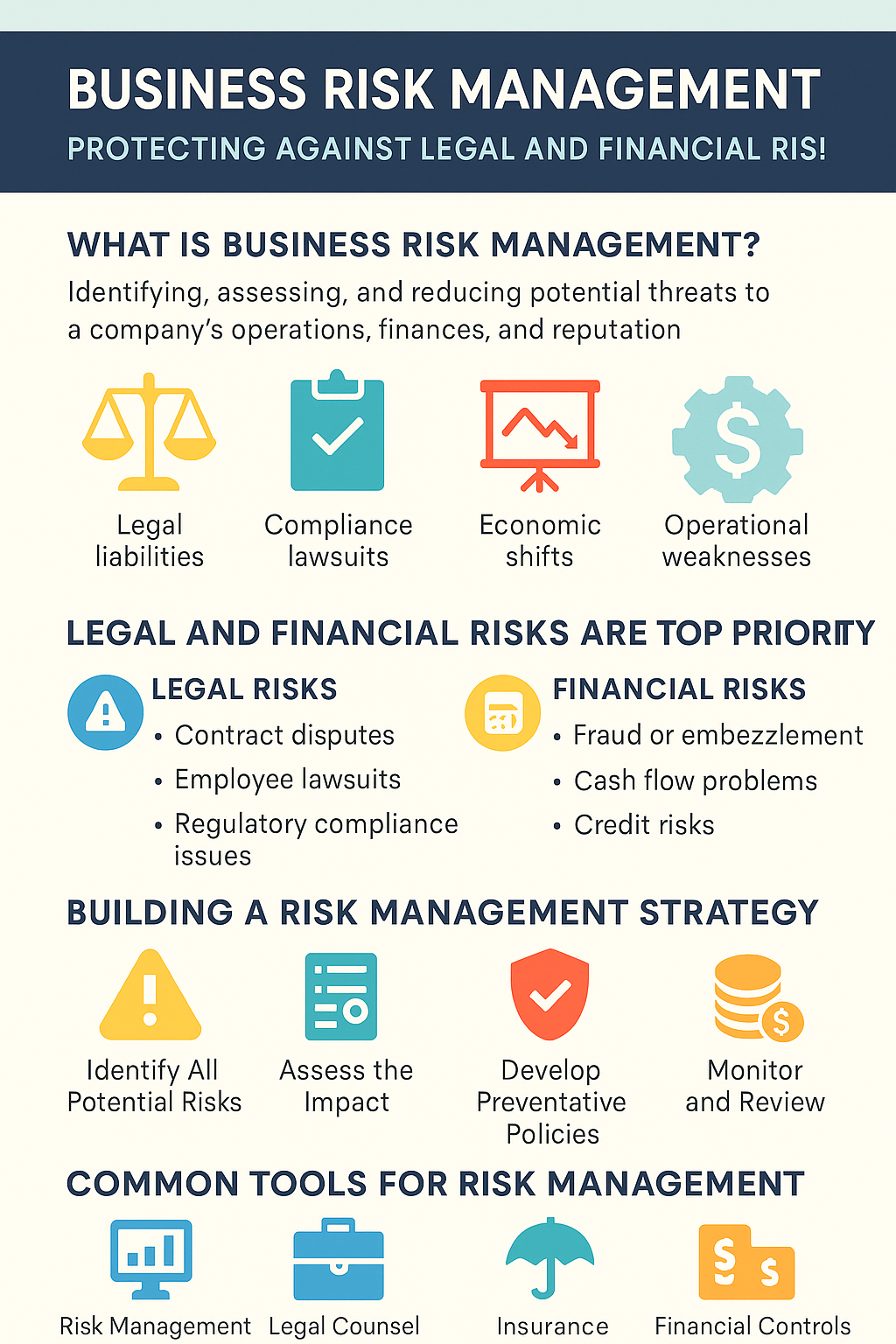Business Risk Management – Protecting Against Legal and Financial Risks
Every business, whether a startup or a large corporation, faces risks. Some are unavoidable. Others, when ignored, can lead to serious legal trouble or financial loss. That’s where Business Risk Management comes in.
This is not just a corporate buzzword. It’s your frontline defense against the unexpected—lawsuits, fines, data breaches, fraud, contract issues, and even natural disasters. Understanding and managing these risks isn’t optional. It’s essential.
Let’s break down what Business Risk Management really means—and how you can use it to protect your business today and tomorrow.
What Is Business Risk Management?
At its core, Business Risk Management is the process of identifying, assessing, and reducing potential threats to your company’s operations, finances, and reputation. These risks can stem from:
- Legal liabilities
- Compliance failures
- Economic shifts
- Cyberattacks
- Operational weaknesses
- Natural or man-made disasters
A good risk management plan doesn’t just react to problems. It prevents them. And when problems do happen, it ensures your business survives with minimal damage.
Why Legal and Financial Risks Are Top Priority
Legal and financial risks can cripple a business faster than most others.
Legal Risks
These can include:
- Contract disputes
- Intellectual property violations
- Employee lawsuits
- Regulatory compliance issues
A single lawsuit can cost hundreds of thousands in legal fees—not to mention the damage to your brand reputation.
Financial Risks
These are threats to your business’s bottom line, such as:
- Fraud or embezzlement
- Cash flow problems
- Investment losses
- Credit risks
If you’re not actively managing these risks, your business might be one crisis away from closing its doors.
How to Build a Solid Business Risk Management Strategy
Creating an effective strategy doesn’t have to be overwhelming. Here’s a practical approach you can start implementing today.
1. Identify All Potential Risks
List every risk your business could face. Go beyond the obvious—think legal regulations, market trends, even the impact of social media mishaps.
2. Assess the Impact
Which risks are most likely to happen? Which would be most damaging? Prioritize your risks based on both probability and potential impact.
3. Develop Preventative Policies
Put controls in place:
- Use clear contracts with suppliers and clients
- Regularly review compliance with laws and regulations
- Invest in cybersecurity systems
- Purchase insurance where necessary
4. Monitor and Review
Risks change as your business grows. Regular audits and reviews ensure your risk management plan stays effective.
Common Tools for Business Risk Management
Here are some tools and systems many companies use:
- Risk Management Software – Tracks risks in real time
- Legal Counsel – Ensures contracts and policies are airtight
- Insurance – From general liability to cyber insurance
- Financial Controls – Regular audits, budgeting software, fraud detection systems
Risk Management Case Study: A Lesson Learned the Hard Way
A mid-size retail company once ignored early warnings from its finance department about unusual vendor payments. A year later, it uncovered a $1.2 million fraud scheme involving a trusted employee and a fake supplier. Legal action followed, and recovery took two years.
A basic internal audit system could’ve flagged the issue in months instead of years.
Moral of the story? Prevention is far cheaper than repair.
Final Thoughts on Business Risk Management
Business Risk Management isn’t about avoiding all risks—it’s about understanding them, preparing for them, and protecting your business from serious harm. When done right, it builds confidence with investors, stability for employees, and trust from customers.
So if you’ve been putting off your risk plan—now’s the time to act. Because in business, what you don’t see coming can hurt the most.

Managing money can feel overwhelming, especially for small business owners and individuals juggling expenses, savings, and investments. But with the right personal wealth management, you can take control of your finances and build long-term security. Already savvy with investing, you can learn about diversified portfolio here. You can learn more about 401k here and Index Funds here.





